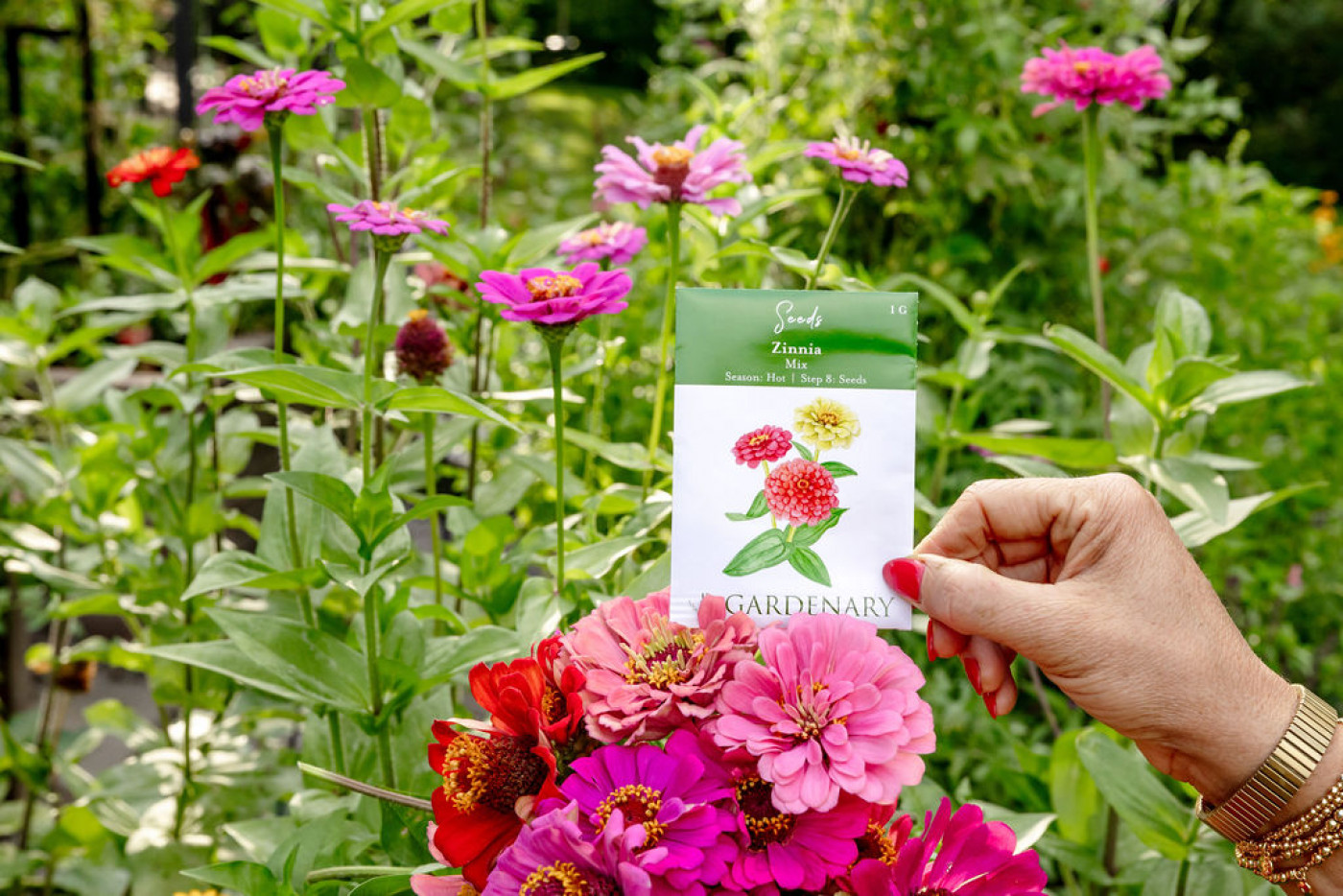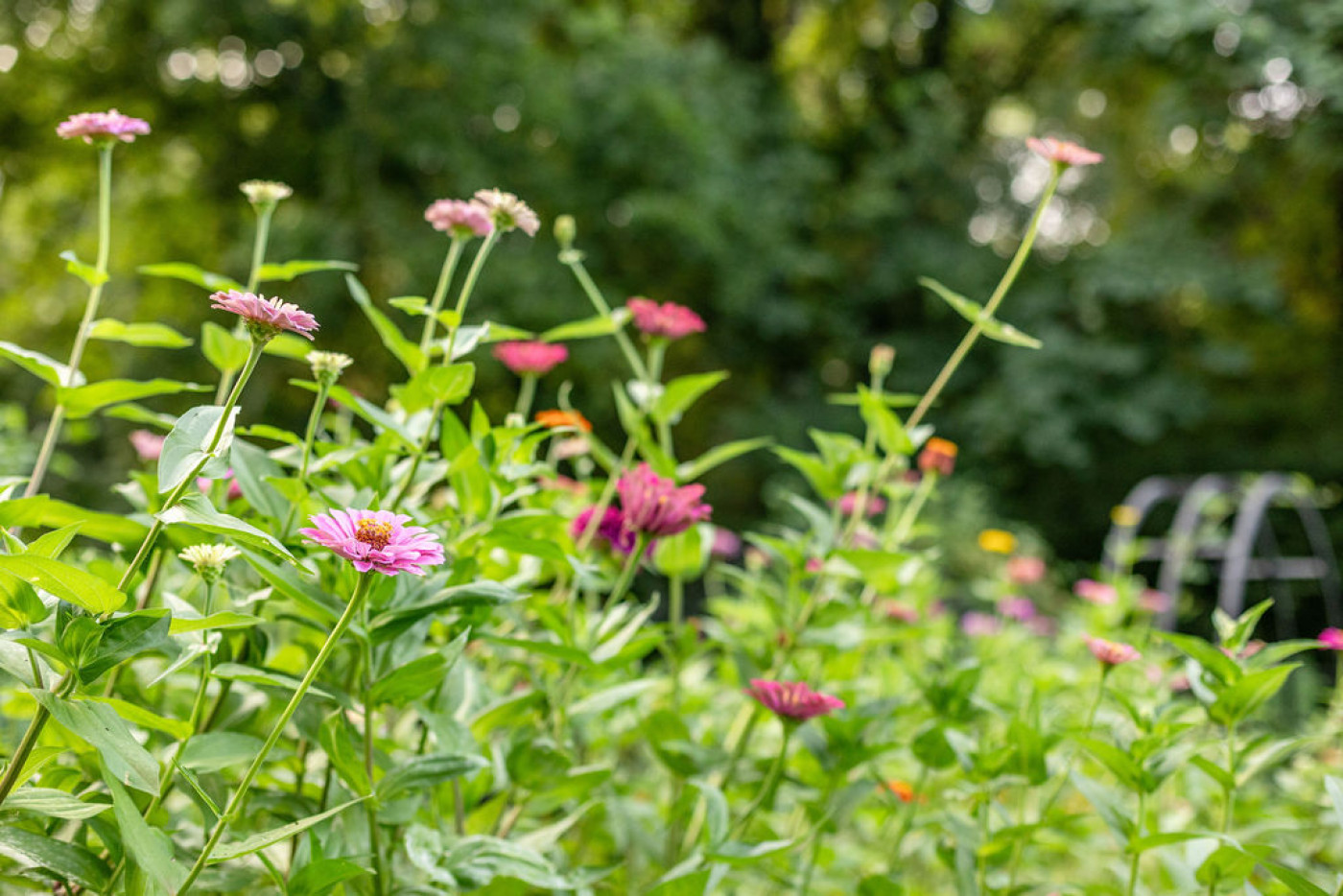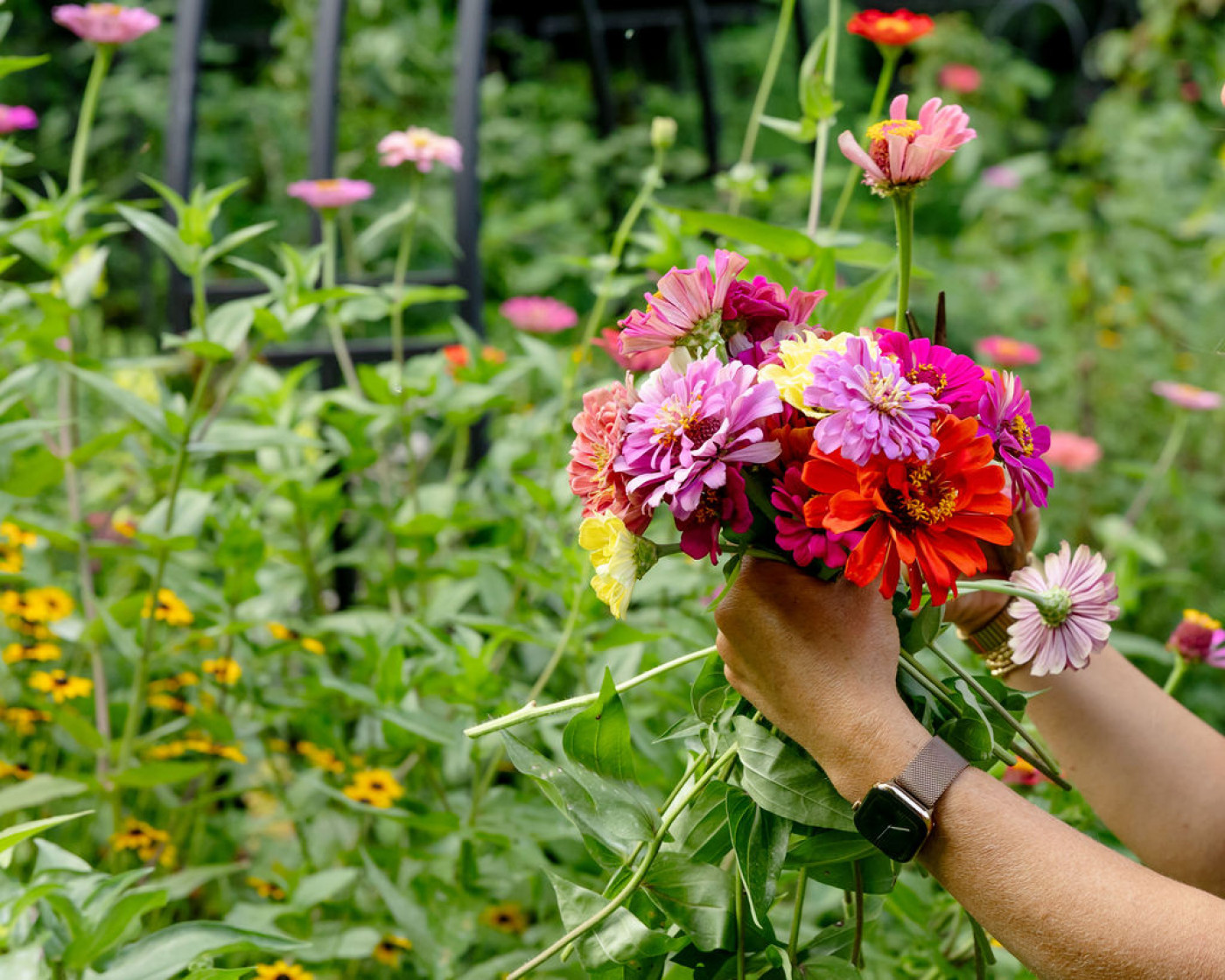Why You Should Grow Zinnias in Your Kitchen Garden
Zinnias are incredibly easy to start from seed, bloom from early summer until your first frost, and will grow under so many conditions, including pretty extreme neglect. We've rounded up our best tips on how to plant, grow, and harvest zinnias, including video tutorials, to help you grow your own zinnias.
Why Growing Zinnias Is Easy
Zinnias are one of the easiest seeds to grow, making them a perfect choice for gardeners who want a big splash of color with very little effort. They germinate quickly in warm soil, thrive in full sun, and don’t ask for much beyond occasional watering. Once established, these cheerful blooms keep producing armfuls of flowers all season long, even if you forget about them for a while. Their carefree nature and constant color make zinnias one of the most rewarding plants you can grow.
But first, here are three additional reasons you should grow zinnias in your kitchen garden, your flower beds, and for that matter, anywhere else you can toss some seeds—in case you haven't already been introduced to this delightful flower.


Start Your Garden the Easy Way
Get growing with 10 foolproof seed varieties, a 120-page gardening guide, planting plans, and step-by-step video lessons—all designed to help you succeed. The Easy Garden Kit makes it simple, fun, and affordable to bring fresh food and flowers to your backyard.
3 Reasons to Grow Zinnias in Your Kitchen Garden
Reason #1: zinnia flowers attract pollinators
Tomatoes, squash, zucchini, cucumbers, and a number of other plants you might grow in your kitchen garden benefit from having bees and butterflies swarming around them and moving the pollen from plant to plant, which ultimately results in more fruit production.
Pollination from bees in particular is critical to our food supply, so it's our job as gardeners to provide a safe habitat for bees and other beneficial insects like butterflies in our garden. Zinnias are basically a welcome mat for these good guys, attracting them by the dozens.
reason #2: zinnias are edible
The flowers are 100 percent edible, petals and all, just like their cousins in the Aster plant family, sunflowers. While I wouldn't eat the stem—it's a little chewy—I love to pick some zinnia petals to arrange on the side of a charcuterie board, use as a garnish, or decorate a cake. I also toss entire blooms into salads to add some pops of color. You can get as fancy as you want.
reason #3: zinnias add beauty to your garden
Besides the tomatoes growing on my arch trellises, the zinnias I have growing in my raised beds and in my pollinator garden are the plants I get asked most about on social media. These floral showstoppers add an enticing layer of beauty and whimsy to your garden.
Are Zinnias Annuals or Perennials?
Zinnias are annuals, which means they complete their life cycle in your garden in a matter of months. If you plant zinnias by seed in the spring, they will flower all summer long and begin focusing on seed production as the weather threatens to get cold in the fall. Some of your flowers might drop seeds that grow next spring (called volunteer plants), but the original plants will not come back after winter.
Annuals tend to produce blooms much faster than perennials, though the downside is that you have to replant them each year.
How to Grow Your Own Zinnias
Do Zinnias Need Full Sun?
Zinnias prefer full sun. If you don't have a spot that receives 8 to 10 hours of sun, your zinnia plants will still grow, but you won't get as many blooms as you would if they were in full sun.
Tips on Growing Zinnia From Seed
I plant zinnias by seed in my raised beds and my in-ground pollinator garden. Zinnias are not super particular about the soil they're being grown in, but they do prefer soil that's well draining. Adding a layer of compost to my in-ground beds is enough to keep them happy and healthy.
I like to plant my zinnia seeds using what I call the Lazy Woman's Method of Planting Zinnias. Basically, find a bare spot in your garden and literally scatter the seeds by shaking them from your palm. Use a small shovel or a hand rake to cover the seeds up a little bit, especially if they’re still attached to the petal (which is designed to help scatter the seeds in the wind).
If you're more the planning type, you could plant an ombre field or rainbow display of zinnias based on the seeds you have. You can be as wild or methodical as you want while you sow your seeds.
Water your seeds in really well.
Zinnias take about 55 to 65 days to bloom.
Elevate your backyard veggie patch into a sophisticated and stylish work of art
Kitchen Garden Revival guides you through every aspect of kitchen gardening, from design to harvesting—with expert advice from author Nicole Johnsey Burke, founder of Rooted Garden, one of the leading US culinary landscape companies, and Gardenary, an online kitchen gardening education and resource company.
When to Plant Zinnia Seeds
Zinnias do not appreciate cold weather. They thrive in warmer weather and full sun, so only sow your zinnia seeds once you're confident all threat of frost has passed.
While some people start their seeds indoors four to six weeks before their final frost date, I've found that zinnias don't like to be transplanted. I wait to sow my seeds directly in the ground, and even in Chicago, I still have plenty of months to enjoy my beautiful zinnia blooms. You could even continue planting your zinnia seeds all the way up to about 60 days before your first frost.
What Do a Zinnia Seeds Look Like?
Zinnia seeds are shaped like little spears and usually gray in color. (Tan seeds might not be viable.) If you buy seeds from the store, they'll already have been separated from their petals, but if you've saved your own seeds, you can keep some petals attached. Keep reading to learn how to save your own zinnia seeds for next year.
The Best Varieties of Zinnias to Grow in Your Kitchen Garden
Zinnias have been bred to produce many different flower sizes and shapes, including singles, semi-doubles, and double blooms, and grow to different heights, some soaring as high as four to five feet tall. With colors ranging from tangerine to dusty apricot, lemon to lilac, and magenta to blush, you're sure to find a color and size of zinnia that works for your garden space.
Zinnia Elegans, AKA common zinnia
Zinnia elegans vary by height, with varieties growing between 12 and 36 inches tall. If you're planting zinnias around the corners of your raised bed or in-ground vegetable garden, look for a shorter variety so that these sun-lovers don't shade your fruiting plants. The taller varieties are perfect for pollinator gardens.
Zinnia Lilliput
Zinnia lilliputs are a type of zinnia elegans that grow as showy round baubles with cheerful centers. Try this Zinnia Lilliput Mix designed for a cut flower garden from Floret Flowers.
My Favorite Zinnia Varieties to Grow From Seed
One of my favorite varieties of zinnias is called the Northern Lights Blend from Botanical Interests. These grow 24 to 36 inches tall and produce long-lasting blooms in a visual feast of colors, including shades of pink, purple, and burgundy.
Another favorite is the California Giants, also from Botanical Interests. This heirloom variety grows up to four feet tall (thus the name) and produces blooms in bold rainbow colors.
A third favorite is just called Cut and Come Again Zinnia Seeds from Botanical Interests. This heirloom variety only grows about one and a half to two feet tall, but is excellent at attracting butterflies in search of summer nectar.
(This is not a paid sponsorship for Botanical Interests, by the way—I just really love their seeds and those from Baker Creek.)
One year, I wanted to do an all-white theme in my pollinator garden. I planted Polar Bear Zinnias from Baker Creek Seeds, which were incredibly beautiful. Unfortunately, this is how I learned that white flowers actually attract cabbage moths and ended up with a raised bed swarming in pests. Ever since, I've planted my beds in a wild variety of jewel tones and vibrant colors, with occasional white flowers throughout.


Join Gardenary 365 to take our Cut Flower Gardens course. In this online course, you will learn how to grow, harvest, and arrange cut flowers. You'll also have access to our complete Gardenary course library inside 365.
How to Maximize Flower Production
How to Get More Blooms From Each Zinnia Plant
Follow these tips to ensure you get the most blooms possible from one plant.
zinnia tip #1: grow your own zinnia from seed
The last thing you want to do is go buy a zinnia plant that's in full bloom from a big box hardware store. Why? Because that plant will likely have been sprayed with gallons of Miracle-Gro or synthetic fertilizers. Not only are these sprays harmful to bees and butterflies, their sudden absence will also stress out the plant when you take it home. Those beautiful blooms will suddenly be like, "Wait, where's my Miracle-Gro?" and the plant will have a difficult time thriving and blooming in your garden space.
I did a little experiment one year and planted a zinnia purchased from a nursery at the same time as I sowed seeds right next to it. After four weeks, the zinnias I started directly in the ground from seed had similar growth to the plant that was supposed to be weeks ahead in terms of maturity—they also just looked healthier and greener. You'll find that plants started by seed in optimal conditions will often catch up to starter plants purchased from a store.
If you absolutely must buy a plant, look for one that's been started organically from a local source.
Overall, you'll see more flower production from plants you start yourself from seed because your plants will have grown up in the very space where they'll bloom and flourish.


zinnia tip #2: give your zinnias plenty of space
Give your plants room to spread out. If you notice seedlings look a little overcrowded, consider thinning or delicately replanting some to ensure each plant has access to plenty of airflow.
I like to put shorter zinnia varieties on the outside of my raised beds, where they have plenty of space away from my large and lengthy plants like tomatoes, squash, and cucumbers. I give taller zinnia varieties their own little patch in my pollinator garden.
zinnia tip #3: cut your zinnia blooms frequently
It might sound counterintuitive, but you'll get more blooms from each plant if you pinch back blooms early in the plant's life cycle. As soon as your first set of blooms opens, come to the base of the flowering stem and cut with a clean pair of pruners. Leave the rest of the branches to produce new blooms.
By removing your first set of flowers, you take some stress off the plant and encourage it to produce more blooms in the future. Take your harvested stems inside to arrange in a vase or, of course, eat.
How to Harvest Zinnia Flowers
For your first set of flowers from each plant, you'll want to do something called pinching them back. Before the flower fully opens, you'll cut right above a leaf node (where two leaves grow directly opposite from each other) with a clean pair of pruners or scissors. I prefer using needle nose pruners, which allow you to get right to spot on the stem where you want to cut.
Pinching your flowers back encourages the plant to branch out and produce more blooms. Zinnias are cut-and-come-again plants, so the more you cut from them, the more they'll produce for you.
After you've pinched off your first blooms, you'll want to continue harvesting your zinnias frequently to maximize your flower production from each plant. I tend to harvest blooms every five to six days. The best times to harvest are in the early morning or the evening.
Cut the stem at an angle right above a leaf node. Avoid cutting all the way at the base of the plant because you'll remove stems that are ready to bloom for you soon. Your goal with each cut is to encourage the plant to split into two new stems that each produce new blooms.
Try not to squeeze the main stem too hard while you work because you could cut off the plant's system of getting water to the flowers.
I like to bring a vase of fresh water for longer stems and a jar for shorter stems out to the garden with me, as zinnias will start to wilt a bit while they're waiting for you to finish up. I remove the leaves, put the stems straight into the water, and get them inside out of the heat as soon as possible. Cutting the stems at an angle helps the flowers last longer once cut, as does changing their water every couple of days.
Bring your harvested zinnia flowers inside to enjoy and watch your plants flourish all the way until your first cold snap.
How to Deadhead Zinnia Flowers to Get More Blooms
Regularly harvesting from your zinnias prevents spent blooms from lingering on the plant and consuming too many of its resources. Should you see a dead or dying flower on your plant, you'll need to do what's called deadheading, which simply means to cut the stem containing the spent flower above a leaf node. This will refocus the plant's energy on producing new flowers instead of going to seed.


How to Harvest Zinnia Seeds
How to Save Zinnia Seeds for Next Year
Towards the end of my warm season, I like to let my zinnias go to seed so that I can harvest and save zinnia seeds for next year. One of the things that got me hooked on the garden was witnessing the magic of seed production. I mean, if you have one zinnia plant, you have all you need to never buy another zinnia seed or plant again.
Learn the step by step to save your own zinnia seeds.
Zinnias Are a Kitchen Garden Must-Have
They're gorgeous, they're beloved by bees and butterflies, and they make incredible bouquets to bring the garden indoors. Because you can so easily save zinnia seeds, one inexpensive seed packet of your favorite variety can produce enough seeds to last a lifetime.
Plus, when we create a garden space bursting with zinnias and other vibrantly colored, organically grown native plants, we're doing good for the whole world. I’d say adding these low-maintenance flowers to your outdoor space is definitely worth the time! Thanks for being part of the kitchen garden revival with me and helping to make little safe havens for our beneficial insects!


Join Gardenary 365 to take our Cut Flower Gardens course. In this online course, you will learn how to grow, harvest, and arrange cut flowers. You'll also have access to our complete Gardenary course library inside 365.










